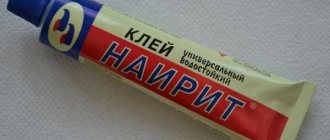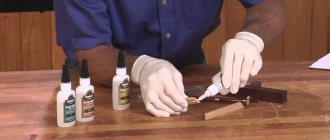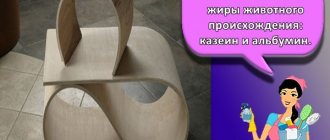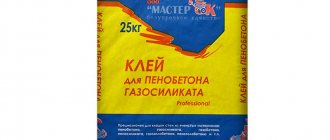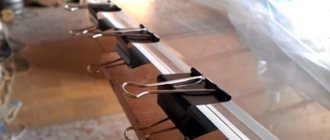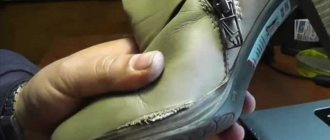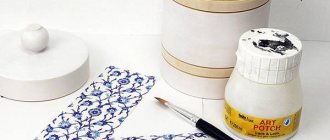Choosing glue for plywood, in most cases, is not difficult. In this case, you need to start from what the plywood is attached to. In construction, this multilayer wood material is used as a subfloor under linoleum, laminate or parquet. In everyday life, you may need to glue plywood sheets together or mount them to another wooden surface. For each type of work, glue is selected individually.
Methods for laying plywood
How to glue plywood to plywood? The most environmentally friendly is water-based glue. It is completely odorless and can be diluted with water and used instead of a primer. This installation requires additional fastening, and the main disadvantage is long-term drying.
Solvent-based glue dries a little less quickly – 3-5 days. In this case, you must first impregnate the concrete screed with a special primer. The disadvantage is the strong smell.
How to glue plywood to plywood and save time? This desire can be maximally satisfied by using two-component glue. It dries in about 24 hours and does not require dowels or nails.
Application of FSF
FSF plywood is considered a more preferable building material compared to the FK brand. The main trump card is its moisture resistance. It is thanks to this property that it is used as a substrate for flexible tiles or ondulin. It is often used for wall cladding in frame housing construction and in the manufacture of external cladding. It is also indispensable when assembling garden benches and making playgrounds.
In construction, it is often used as the main sheet material for formwork - such a sheet can withstand up to 100 cycles of concrete pouring when used as replacement formwork.
Now that all the advantages and disadvantages of the most popular types of plywood are known, it is not difficult to determine what type of material a particular sample belongs to, and how it can be used in construction, design, or children's crafts.
How to choose glue for plywood
Deciding on what is the best glue to glue plywood to plywood depends on the type of connection and further operating conditions. The process can be represented by independent installation of plywood on a screed or have an additional function, for example, strengthening the structure.
If you plan to use unveneered plywood, then you can purchase any glue. The main requirement is a dry and clean surface. To apply the composition to both surfaces to be glued, it is better to use a roller or brush. After this, you can strengthen the plywood connection with nails, screws or clamps. Finally, you need to remove the excess mixture.
How to glue plywood to plywood if whole sheets will be used? You just need to cover the surfaces with the mixture and then press them down with temporary dowel nails.
It is not recommended to glue a laminated surface covered with a film, so before applying the epoxy compound, the sheets must be sanded with sandpaper.
How to glue plywood to plywood so as not to disturb the texture of the material and not cause a change in color, but at the same time obtain a high-strength structure? PVA glue is ideal for interior work, and phenol or epoxy glue for exterior work.
The level of reliability of the connection is affected not only by the mixture applied, but also by strict adherence to the recommendations, since if the latter are violated, the properties of the glue may not be fully revealed.
Additional recommendations
In addition to the recommendations described above regarding working with laminated and other materials, you need to take into account that to create a more durable connection, you should use the glue with which the plywood is impregnated. However, it is also necessary to pay attention to the purposes for which the sheets will be used in the future.
How to glue plywood together with your own hands?
Glue composition
Almost any adhesive for gluing plywood is based on the following components:
- main adhesive ingredient;
- solvent;
- filler, which is usually used as wood dust or flour;
- additives that directly affect the rate of hardening and maximum adhesion;
- plasticizer;
- antiseptic.
The hardener is usually some kind of acid or ammonium chloride, and resistance to wetting is guaranteed by the presence of tannins (formalin, copper salts, etc.).
Gluing Basics
When answering the question “how to glue plywood?”, you need to consider all the options for the proposed adhesive compositions and choose the best one.
There are two types of glue origin:
- Animal (protein):
- Curd production (casein) is a dry mixture that requires the addition of water.
- Protein production (albumin - from animal blood) - a dry mixture that requires the addition of water in accordance with 1 to 9.
- Combination of curd and protein production (combined).
- Synthetic:
- Urea-formaldehyde resins are colorless, low content of volatile phenols. Suitable for gluing decorated elements due to the colorless seams.
- Phenol-formaldehyde resins are waterproof, resistant to the formation of fungus and mold.
Almost all types of glue contain:
- The main gluing element.
- Wood dust formation.
- Solvents.
- Hardeners, tannins.
- Plasticizers.
- Antiseptics.
To dilute the sticky element, either wine ethanol or a solvent is used.
Which glue is better: “KS” or “Tarbikol”?
When deciding how to glue plywood to plywood, people most often choose “KS” or “Tabrikol”.
A little more about their properties and features:
- “KS” glue is a universal composition characterized by a viscous consistency. The composition includes sodium liquid glass, as well as several mineral fillers and additives. It is very convenient to use, in addition, it is not afraid of humidity, high temperature and cold. The question is, how to glue plywood to plywood on the floor? "KS" glue will easily solve all the difficulties associated with parquet boards, fiberboard and chipboard products, ceramic tiles and glass.
- "Tarbikol" is a one-component polyurethane mixture with which you can lay any parquet. Its main positive qualities include: good sound insulation, absence of water and solvents, resistance to ultraviolet rays and high humidity. In addition, Tarbikol comes in two components and is designed to work with non-absorbent bases of varnished parquet. It dries very quickly, so it is indispensable in conditions of limited repair time.
Main varieties
When choosing an adhesive for splicing plywood, you must take into account the requirements for the following compositions:
- ease of use;
- viscous or semi-viscous consistency;
- fast hardening;
- absence of volatile toxic substances in the composition;
- resistance to moisture;
- presence of antiseptic properties (not affected by bacteria).
For plywood that is located indoors, any compositions can be used. For splicing materials used outdoors, synthetic glue is suitable; for moisture-resistant boards, it is based on urea resin.
Aqueous or water-dispersed
Among similar adhesive compositions, PVA is most popular. These products do not contain toxic substances or components that emit unpleasant odors. The glue gains sufficient strength within a day, but it takes 2-3 days to completely harden. Due to the fact that PVA and other similar products are water based, these products cannot be used to bond plywood sheets with a porous surface that absorbs moisture.
Carpentry
The basis of carpentry compositions are fats of animal origin: casein and albumin. Both products are available in the form of a dry mixture, which must first be diluted in water. Albumin compounds are used for hot gluing, due to which the created joint gains strength faster.
Based on urea and phenol formaldehyde
Adhesives based on this type contain natural resins that are less toxic than epoxy ones. Compositions of this type are used exclusively for joining wooden products. Glue with such a base creates a transparent seam, so similar products are used to repair decorative elements.
Epoxy and polyurethane
The basis of such compositions are solvents containing toxic substances and emitting a pungent odor. Therefore, it is recommended to work with such products in ventilated areas or outdoors.
Epoxy adhesives are divided into one- and two-component. Compositions of the first type are immediately ready for use. Two-component products consist of an adhesive and a solvent, which must be mixed before starting work. Such compositions are used for rapid joining of various materials, including wood.
The influence of plywood grade on the choice of adhesive composition
The brand of suitable plywood adhesive directly depends on the level of strength required and on how high the humidity is in the room in which the structure is planned to be used.
What glue should I use to glue plywood to plywood if the finished product will be located in a well-ventilated room? PVA, protein or synthetic, works well.
If you plan to make country furniture that will be located both indoors and outdoors, then it is better to use one of the synthetic compounds.
Once the choice has been made in favor of a moisture-resistant material for the interior, you need to determine how to glue the plywood to the plywood. Reviews indicate that the connection is best done with compounds based on urea resin. The use of uncoated sheets makes it possible to glue plywood with any type of glue.
Useful tips
Advice from professionals can help you get better results. So processing can begin only on a dried surface. Study the instructions for the adhesive solution in advance; adhesives have specific preparation and use requirements.
Observe the required temperature and humidity conditions during operation. The position of the parts must be adjusted before the glue sets.
Processing can only begin on a dried surface.
Gluing plywood to plywood is not so difficult; the process can be done with your own hands. But you should carefully choose the appropriate adhesive and follow the instructions from the manufacturer so that the composition provides high-quality adhesion of the parts.
How much glue is needed to lay plywood on a concrete surface?
The amount of consumption depends on the number of irregularities, the presence or absence of porosity and the quality of the screed. You should proceed from the recommended consumption of 1.2-1.5 kg/m2, but do not forget that the plywood must be laid on a base without voids. Only uniform pressing of the plywood to the base can ensure optimal distribution of the glue over the entire surface.
The simplest connection: butt mount
The easiest way to join two pieces of plywood is to butt them end-to-end. It is best to use self-tapping screws as fasteners. If you use screws, the holes for them must be drilled in advance.
Butt fastening is used for thick sheets of plywood. It is considered strong enough for use in furniture production. Its strengthening is facilitated by the facade piping and the pressure exerted by neighboring modules.
Attention! The diameter of the self-tapping screw or screw should not exceed 1/3 of the sheet thickness. So, for 15 mm plywood, fasteners with a diameter of 4–5 mm are suitable.
Plywood gluing sequence
Before you get started, you should figure out how to glue plywood to plywood. The instructions below reveal all the intricacies of this process in as much detail as possible:
- First, the plywood sheets need to be cleaned of dust and various types of contaminants. To remove the laminated layer you will need sanding paper.
- Then the plywood should be thoroughly dried.
- It is recommended to distribute the glue to obtain an even layer using a roller.
- Now you need to press the plywood parts together with clamps. It is recommended to remove protruding excess with a knife and rags.
- If there are large parts, they will need to be connected with nails.
- Finally, when the adhesive mass is completely dry, the product must be freed from the clamps.
Coffee table made from plywood scraps
A lot has been said about how to glue plywood to plywood, but how can you make something useful from this material?
After carrying out various repair work, a lot of plywood scraps remain, which are simply sent to the trash bin.
But these pieces are ideal, for example, for creating an unusual and beautiful coffee table.
List of materials and tools required for work:
- a whole small piece of thick cardboard for a template;
- many plywood pieces of the same thickness, which will make up the main structure;
- moisture-resistant adhesive for wooden surfaces;
- jigsaw;
- pencil;
- vice;
- a circular saw;
- Sander;
Gluing plywood: a practical example
How to quickly make a plywood table? First you need to make a paper template for cutting out the legs of the product. A coffee table will look good on openwork or curved legs.
You need to take a large sheet of paper and draw legs on it on a scale of 1:1. When transferring the design onto cardboard, remember that the finished structure should be placed on symmetrical legs.
After completing the work with the template, you can proceed to gluing the plywood pieces. The structure must be manufactured in such a way that the shape resembles the future table legs. Gluing each 2 parts must be accompanied by removing excess mortar and tightly compressing the plywood pieces. To complete the work, the legs should be placed on a flat surface, a template should be placed on top of them and the outline should be traced with a pencil. To trim off the excess structure, you will need a jigsaw. Place the tabletop on top of the product and connect the parts together.
Right angles are the main rule of assembly
Homemade mounting squares will help you set right angles.
The use of mounting angles for joining plywood parts.
Make several sets of these simple devices of different sizes with your own hands from pieces of chipboard and use them when assembling large and small products.
Details of the mounting angle: 1 – corner; 2 – long bar; 3 – short bar.
Saw a square piece measuring 290x290 mm diagonally.
Manufacturing of mounting angles for joining plywood parts.
Mark the cutouts for the clamps on the corners and cut out the excess material.
Prepare the side strips and make countersunk holes in them.
Secure the corner to the workbench by placing pads of suitable thickness under it. Tighten the screws, drilling pilot holes.
Cut a right angle at the junction of the planks so that during assembly it does not interfere with the tight fit of the parts.
Ready-made mounting angle for joining plywood parts.
You can also make a mounting square with your own hands from thick plywood. Side strips are not needed here; the material is strong enough to be secured with clamps directly to the end of the device.
Drawing of a plywood mounting bracket.
